Ongoing research by a Purdue professor has solved a major underlying flaw in 3-D printing, which may one day put a base on the moon.
via Research team helping improve quality of 3-D printing technology – Purdue Exponent: City & State.
After putting up with ever worsening oil and water leaks, and oil consumption through cylinder #7, it was time to tear down my 351W to replace every gasket and seal. I knew the rear main had leaked for some time. Finding nearly a pint of oil in the bell-housing confirmed that. I made the mistake of not removing the pin in the rear main cap when I replaced the rope seal with the neoprene seal in 2003. Always read the directions!
The photo below (3/10/2013) shows where the intake gasket was broken next to the lifter galley on cylinder #7: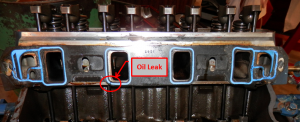
The right side gasket was mangled beyond belief. Surprisingly, neither cylinders 2 or 3 showed any signs of running too lean. This time I will use the Edelbrock gaskets instead of the Fel-Pro gaskets, and will be more careful about the torque sequence.

The next photo shows the damage to cylinder #1 caused by a warped TFS Twisted Wedge aluminum head in 2002. The machinist in Danville, IL wasn’t willing to sleeve it. I’ve now found a machine shop (Terry Cummings racing engines) in Bedford, IN that can, and very reasonably.
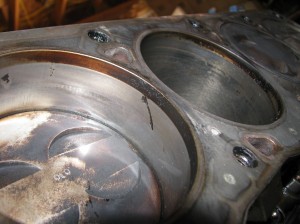
Cylinder #1 scratch
I also had to replace the cam thrust bearing, because the original was cracked. Photo taken 3/23/2013.
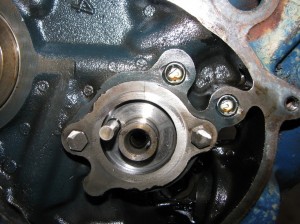
cracked cam thrust plate
In-progress photo of the engine reassembly after cylinder #1 was sleeved by Terry Cummings Racing Engines in Bedford, IN. Photo take 4/10/2013.
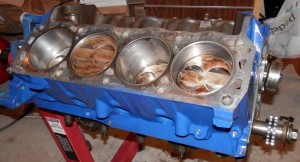
Cylinder #1 sleeved
Ready to re-install the intake manifold. The left cylinder head had to be heli-coiled on two places. In hind-sight, I should have swapped heads due to the configuration of the EGR plugs. The right-hand cylinder head had a deep plug in the front that I couldn’t remove. I was able to cut down a plug with a 3/8″ internal thread to mount the new alternator bracket.
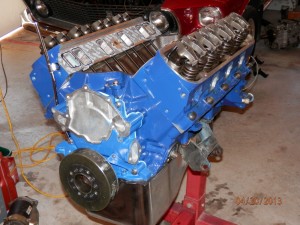
Reassembled with new timing cover.
The photo below shows what happens when attempting to use comp-cams roller tipped rocker arms with 1970’s vintage cobra valve covers. The impression made by the rocker arms is visible near the lower bend, along with a fatigue crack. Both valve covers showed similar damage.
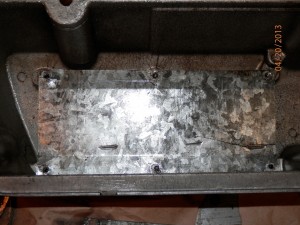
Damaged baffle in valve cover
I fabricated custom baffles to replace the originals, with slightly more clearance, and I used steel lined valve cover gaskets from Summit Racing (advertised 0.20″ thick, actually 0.17″ thick).
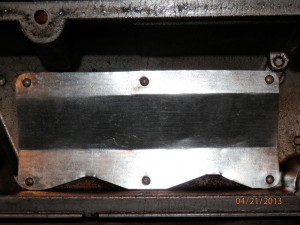
custom valve cover oil baffle
Engine re-installed 4/28/2013:
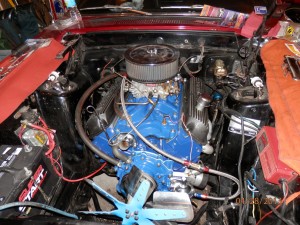
Engine re-installed
I’m restoring a primitive cabinet that my father started to work on some time in the mid to late 1980’s. It appears to have a cherry front with the rest made from rough cut material, mostly from Montgomery Ward shipping crates. The entire cabinet is nailed together, using wire nails, which means it had to be built after 1880.
I found an old receipt buried inside dated from the 1930’s. The cabinet may have been in a store of some kind, it has 12 small drawers in the top cabinet. It originally had 2 glass doors, but one was missing. One of the base-cabinet drawers was also missing. I’ve managed to duplicate the cabinet door down to the joinery, although my replacement will have tighter joints and no saw marks. Repairing or reproducing pieces with the same roughness and material thickness has been very difficult. Luckily my step-father happened to find a thick piece of cherry that we planed to the correct thickness for the drawer front and door parts. I re-sawed some 3/4″ thick pine recovered from a desk I built around 1984 to make the drawer bottom. I can’t duplicate the crate material or roughness, but I can duplicate the construction. Minwax early-American stain seems to be reasonably close to the aged pine color, and seems to darken the cherry to about the right shade also.
The original door hinges were much too small, and the cabinet and the one remaining door were both badly damaged by the hinges. Pieces were broken out and missing. I was able to mill out a portion of one door stile to repair it, and a small patch in the top-cabinet.
When it is all done, it will be as good as or better than when it was new, while retaining as much of the original character as possible.
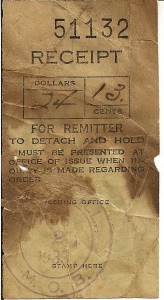
1938 receipt
pJohn Gregg, the Democratic candidate for governor, took time to speak with The Exponent about higher education while making one of his campaign…/ppvia a href=’http://www.purdueexponent.org/city/article_99388989-9524-5c70-ae55-60016a2baf7d.html#.UI8tmVD0HWs.wordpress’John Gregg Makes Stop at Nine Irish Brothers. – Purdue Exponent: City/a./p
Interview by Mason Sale.




























